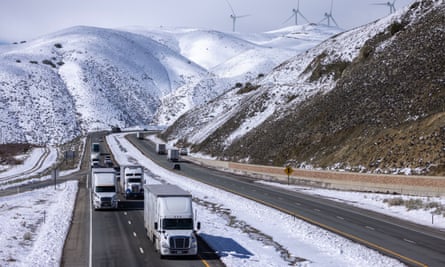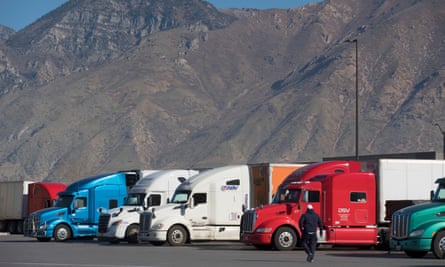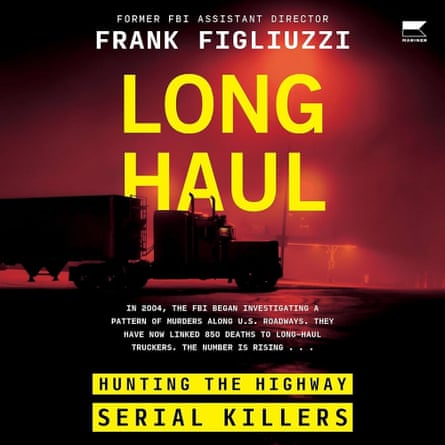The last photos of Regina Walters show the 14-year-old forced into a black dress and high heels, her face contorted in fear, her palms raised as if imploring mercy. Soon after she would be strangled to death and her body left to decompose in an abandoned farmhouse.
Regina was murdered by Robert Ben Rhoades, known as the “Truck Stop Killer”, a long-haul trucker who built a torture chamber in the rear of his semi and over at least 15 years kidnapped, tortured, raped and killed as many as 50 suspected victims before being caught and jailed.
It is tempting to dismiss Rhoades as an isolated case, a one-off sociopath. Frank Figliuzzi’s book Long Haul: Hunting the Highway Serial Killers denies readers that comfort. On the contrary, it argues, he is part of a wider sociological phenomenon hiding in plain sight. Long-haul trucking is the number one profession of serial killers.
“Part cowboy, part fighter pilot, and part hermit, long-haul truckers glide along the edge of a certain seam in the fabric of our society – the seam that separates their reality from ours,” the author writes. “Killer truckers exploit that seam.”
Figliuzzi, a former assistant director of Federal Bureau of Investigation (FBI) who served in the bureau for 25 years, was himself floored to learn of at least 850 murders along America’s highways over the past few decades. More than 200 cases remain active and unsolved; the bureau has a list of about 450 suspects.
Their victims are almost all sex-trafficked women, often picked up at truck stops in one jurisdiction, sexually assaulted and murdered in another, then dumped along a highway in the third. Twenty-five long-haul truckers are serving time in prison for multiple homicides and the crimes are still occurring today, albeit at a slower rate than in the 1990s and 2000s.
The crisis was such that FBI opened a special unit, the Highway Serial Killings (HSK) Initiative. But Figliuzzi, his old investigative instincts kicking in, wanted to know more. “What intrigued me is all of these subcultures literally are under our nose,” the 61-year-old says from Houston, Texas. “We drive on our highways every day. These trucks are right alongside us, up to 80,000lb or more of steel and iron.
“We have this American mystique about the long-haul trucker because of the prevalence of our interstate highway system and they do have this cowboy mythology around them. They’re kind of lone operators out there, very isolated, but for many people they’re a mystery.”

Trucking is a lifeblood of the American economy. Last year the industry was worth $850bn in gross freight revenue, with everywhere from factories to supermarkets to the Pentagon dependent on its timely deliveries. Drivers are diversifying, including immigrants and women, and dealing with new technologies such as cameras, GPS tracking and the looming threat of self-driving trucks.
Figliuzzi, an NBC News and MSNBC national security contributor, rode in a truck for more than 2,000 miles to understand the subculture from the inside. He slept in the top bunk in the sleeper berth and sometimes cooked meals inside the cab – he happened to be with a trucker who was an accomplished chef but quit that work because driving was more lucrative.
“I came away impressed with the modern-day trucker,” Figliuzzi says. “If this young man, 26 years old, is the future of trucking, we’re in good shape: he was bright, hardworking, had social skills – he spent much of his time in the truck chatting on his headset with friends and co-workers. That’s a good thing and I dedicate my book in part to the stalwart American trucker. I’m quite careful to point out that we’re talking here a tiny fraction of long-haul truckers that actually give other truckers a bad name.”
Aa Figliuzzi observed, it is mentally and physically taxing work, often tedious and solitary, and can take a toll on the driver’s health. “It’s part of the negative side of the culture that they’re incredibly sedentary for hours on end. There’s little or no human engagement, depending on the type of trucking you’re doing.”
Which raises the question, does the occupation of long-haul trucking attract sociopaths, or does the toll of the job aggravate sociopathic tendencies?
Figliuzzi replies: “A certain type of personality might be attracted to long-haul trucking because of their personality since it is isolated and they’re perfectly fine with that and the lack of engagement with others.
“Does it present to them an opportunity to commit crimes, even murders, largely undetected, exploit the seams in jurisdictions – grab a victim in one jurisdiction, kill them in a second jurisdiction, dump their body in a third jurisdiction – and be on their way before anyone has figured anything out? Yes.
“But in the same vein there’s a thing that happens in years of exposure to trucking that causes clinical depression – incredibly sedentary lifestyle, incredibly bad diets. I tried very hard that week but inevitably it’s tough to get something healthy in truck stop places and food diners.”
He adds: “I quote from a Canadian health study on truckers that shows the stress, the pressure of operating that truck, knowing you literally have the power of life and death with 80,000lb of steel. Drivers of cars make terrible mistakes cutting a trucker, trying to pass a trucker on an exit or entrance ramp, and they can’t stop for you. We had near misses when I was driving.”
Figliuzzi also points to an anonymous survey of truckers that found 10% say they drink alcohol every day, 20% say they binge five or more drinks at a time and 44% are experiencing symptoms of major clinical depression.
His book is not only about trucking but also the subculture of sex trafficking, research that took him to two experts: Celia Williamson of the University of Toledo and Dominique Roe-Sepowitz of Arizona State University. “These two professors taught me what to look for in terms of commonalities in the backgrounds and lives of trafficking victims.”

Figliuzzi interviewed women who had survived violent encounters with truckers and found commonalities regardless of their backgrounds. “Trauma at an early age, often involving unwanted touching or sexual molestation. Trauma in the family – someone’s committed suicide, some close loved one has died – or all of the above. Serious medical problems in the family – dysfunction somewhere along the line.
“Then a series of bad boyfriends. Early drug use, usually starting with marijuana and rapidly getting to hard drug use where your judgment goes out the window and, sure enough, the grooming process falls in place where they think at the time: you know what, I am having sex, I might as well have it for money because I need to get the drug problems handled with getting more drugs supply. The boyfriend’s encouraging that or facilitating it.”
Just as it would be facile to assume that all truckers fit a single demographic profile, so the victims of trafficking do not fit stereotypes around class and privilege.
The author adds: “I threw out my biases and preconceptions here because many folks believe, ‘I don’t know any young lady in my circle of contacts, family, friends who is in danger of falling into the trafficking trap. It’s not going to happen here.’ I’m telling you that’s wrong and I was corrected in my research.”
Figliuzzi encountered, for example, two young women from the midwest, one the daughter of a preacher, the other from a family with ties to law enforcement. Both had many of the commonalities listed above.
“It can happen to anyone and increasingly that grooming and recruitment process is happening online. So many Americans watch movies where some kid’s grabbed off the sidewalk, thrown in the back of a van and then trafficked internationally. That’s extremely rare.

“What is more likely is that it’s someone in your young person’s life that they kind of know, that’s on the periphery maybe but they’re going to get introduced. The grooming and recruitment happens online. The drug use is introduced and this is why it’s imperative that parents understand what their kids are doing online.”
Having diagnosed the problem, Long Haul offers solutions. Figliuzzi argues that trucking companies should improve their vetting of drivers, offer them more downtime and close loopholes that make it easy to fake the annual physical exam. He advocates making tracking devices mandatory in all trucks, including those operated by smaller companies.
On the trafficking side, Figliuzzi sees hope in the work being done by Roe-Sepowitz, who has done hundreds of interviews and analysed the online ads in which women offer truckers sex for money. “Algorithms have been developed to determine whether an ad is probably advertising an underage minor,” he says.
“There is a positive change occurring in police work, which is the days of treating a trafficking victim, someone in the sex trade, as a criminal and handcuffing her and throwing her in a lock-up, where the ‘hero’ shows up who is her pimp and bails her out, are rapidly coming to a close.
“Instead in the best cities the police say, ‘We’re partnered with some social services organisations. You’re not getting arrested tonight if you want help. We can get you out of this. Tell us what you need and, by the way, here’s a social worker who’s here to give you what you need. Do you need a roof over your head to get away from your pimp? Do you need a job or job training?’
“They’ll often say I’ve got a baby I have to get diapers and formula for. Here comes that resource to build the trust and get them out of the lifestyle. The police find once that trust is developed with the social team the victim will eventually say, ‘I’ll tell you who my pimp is and I’ll tell you how many women he’s got in his stable and how this works’. That is successful.”
Long Haul: Hunting the Highway Serial Killers is out now